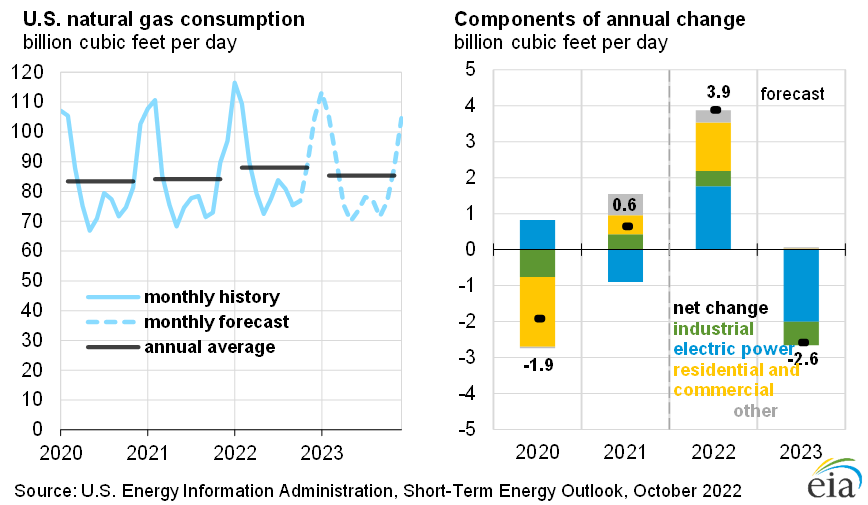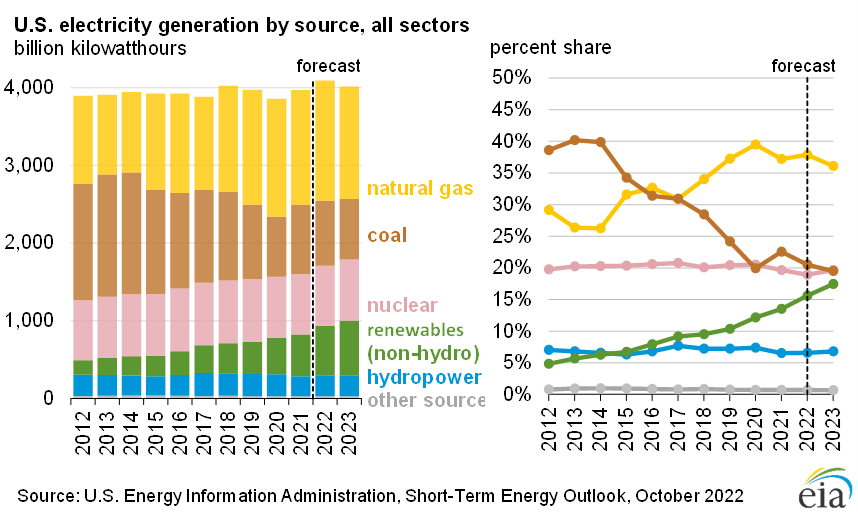EIA Winter Fuels Outlook

Many households across the United States are likely to spend more on energy in the winter of 2022–23 compared with recent winters. Higher forecast energy expenditures are the result of higher fuel prices, combined with higher heating demand because of a forecast of slightly colder weather than last winter.
Based on forecasts for the Consumer Price Index from the S&P Global macroeconomic model, the U.S. Energy Information Administration (“EIA”) assumes inflation will average 6%–7% this winter compared with last winter. Given that rate of inflation, changes in expenditures and prices adjusted for inflation would be roughly 6%–7% less than the values reported.
For this outlook, EIA defined the winter heating season as October through March. Weather is a key input to their energy consumption forecast and based on the weather forecast from the National Oceanic and Atmospheric Administration (“NOAA”), EIA expects increases in winter energy consumption.
Based on NOAA’s most recent winter forecast, EIA assumes temperatures for the winter of 2022–23 in most of the country will be slightly colder than both last winter and the average winter for the previous 10 winters. Cold weather can affect household heating expenditures in two ways. First, cold weather raises the amount of energy required to keep a house at a specific temperature. Second, because cold weather raises demand and could cause supply disruptions, it can cause energy prices to rise, which could be more severe during a time of low fuel inventories.
Natural Gas
Nearly half of all U.S. households heat primarily with natural gas. EIA expects households using natural gas as the primary space heating fuel will spend about $930 this winter, 28% more than they spent last winter. Their forecasted increase in natural gas expenditures is the result of both higher expected prices and consumption.
EIA forecasts that residential natural gas prices will increase in all regions of the United States this winter, with natural gas spot prices at the U.S. benchmark Henry Hub averaging $7.26/MMBtu this winter, up 54% from last winter. EIA expects the largest increase in residential prices to occur in the Midwest, where EIA forecast that prices will average 27% higher than last winter. EIA expects residential natural gas prices to increase by 15% in the South, 17% in the Northeast and 23% in the West. If spot prices continue to rise, retail prices this winter could be even higher than their forecast.

Natural gas inventories. Working natural gas inventories in their forecast reach almost 3.5 trillion cubic feet (“Tcf”) by the end of October, which would be 6% below the previous five-year average. U.S. natural gas storage injections usually take place from April through October, although injections often occur in early November, depending on temperatures and market conditions. Storage withdrawals typically occur from November through March. U.S. natural gas inventories began this injection season at the lowest level in three years because of high heating demand in January and record LNG exports. The above-average withdrawals last winter, combined with more-than-average consumption this summer, contribute to their forecast for below-average storage inventories heading into the winter heating season.
EIA expects natural gas supplies to be adequate to meet winter demand; however, wholesale price volatility and localized wholesale price spikes could occur during severely cold temperatures.
Heating Oil
EIA expects that the 4% of U.S. households that use heating oil as the primary space heating fuel will spend about $2,350 on average this winter, up 27% from last winter. The increase in heating oil expenditures reflects their expectations for higher retail heating oil prices and more consumption than last year. EIA forecasts that the average U.S. household will consume about 520 gallons of heating oil this winter, up 9% compared with last winter, which reflects NOAA’s forecast of a colder winter. The retail price of heating oil in their forecast averages $4.54/gal during the winter of 2022–23, up 16% from the previous winter. Higher heating oil prices are driven by higher refining margins than last winter, partly offset by slightly lower crude oil prices.
In the EIA forecast, the Brent crude oil price, which is the most relevant crude oil price in determining U.S. petroleum product prices, averages $2.22/gal, or $93/barrel (“b”) this winter, which would be 7 cents/gal higher than last winter. EIA expects crude oil price pressures to be more to the upside in the coming month following the OPEC+ announcement of a production cut on October 5, which are reflected in this outlook.
Lower natural gas moving from Russia into Europe may further contribute to lower international distillate availability. With the impending implementation of the European Union’s ban on Russia’s petroleum products in February 2023, the potential for increased fuel switching from natural gas to distillate presents a greater source of price uncertainty than in previous years.
Distillate fuel inventories. Distillate fuel inventories (which include heating oil and diesel fuel) on the East Coast at the end of September were 25.5 million barrels, 45% below the five-year average. Almost 60% of East Coast distillate inventories are in the Northeast. Inventories in the Northeast ended September 57% below the five-year average. Several factors have contributed to low distillate inventories in this region, including limited regional refining capacity, increasing domestic distillate demand in the first half of the year, and low imports as a result of generally tight distillate markets worldwide.
In the context of reduced imports and limited refining capacity, relatively strong distillate demand early in the year contributed to low inventories. Although refining margins are well above their previous five-year high, the ability to increase refinery utilization or yields in response to winter distillate demand is limited. EIA forecasts gross refinery inputs will average 15.8 million barrels per day (“b/d”) this winter, which is 2% lower than last winter. This winter, EIA expects refinery and blender production of distillate fuel will average 4.8 million b/d (almost identical to last winter).
Distillate fuel imports and exports. Imports of distillate fuel into the East Coast in the first half of 2022 averaged 167,000 b/d, down 40% from 1H21. Prior to Russia’s full-scale invasion of Ukraine in February, Russia was a leading supplier of distillate fuel to Europe. U.S. and UK sanctions on Russia from the invasion and the independent choices of private sector companies to abstain from trade with Russia have reduced distillate supplies coming from Russia. In addition, demand for distillate fuel in Europe’s electric power sector has increased because of record-high natural gas prices in Europe, further tightening Atlantic Basin distillate markets. This year, U.S. East Coast imports of distillate fuel averaged 361,000 b/d in February and fell to an average of 113,000 b/d from March through June.
Electricity
EIA forecasts that U.S. households that heat primarily with electricity will spend 10% more on electricity than last winter, at an average of about $1,360. This increase is based on their forecast of 4% more electricity consumption and 6% higher residential electricity prices. Nearly all U.S. households use electricity in some form, but 4 out of 10 households rely on electric heat pumps or electric resistance heaters as the primary source for space heating. Nearly two-thirds of homes in the South heat primarily with electricity. Electric heaters are also commonly used as a secondary heating source in many U.S. homes.

Propane
About 5% of all U.S. households use propane as the primary space heating fuel. EIA forecasts that households in the Northeast, Midwest, and South will spend 5% ($80) more, on average, for propane this winter compared with last winter, driven by higher expected consumption. EIA does not forecast expenditures for the West Coast because EIA does not collect propane price data for the West Coast in their surveys.
Propane inventories. Propane inventories typically build in the United States between April and October and begin drawing down in late September or October, when agricultural use of propane rises and heating use picks up. EIA estimates that at the end of September, U.S. propane (including propylene) inventories were more than 84 million barrels, about the same as the five-year average but 15% more than at the same time last year. At the end of September, inventories in the U.S. Gulf Coast (which account for about 55% of all U.S. inventories) were 4% more than the five-year average, and in the Midwest (which accounts for almost 30% of U.S. inventories) they were 9% below the five-year average. Inventory levels in the Northeast were 2% above their five-year averages.
Propane inventory builds in the United States, and particularly on the Gulf Coast, were limited this summer as a result of global propane market dynamics. U.S. propane exports averaged almost 1.4 million b/d during the first seven months of 2022, the most on record during that period. Global demand of U.S. propane was strong because of rising consumption in the petrochemical sector.
Propane imports and exports. EIA forecasts U.S. propane exports this winter will be greater compared with last winter as a result of strong global demand for propane as a petrochemical feedstock as well as more exports to Europe for winter heating. Propane inventory levels in Western Canada, which are near the five-year average, are increasingly being used for export at their two marine terminals, which may limit the quantity of propane available for import into the Midwest.
To read the full Winter Fuels Outlook report, click here.
